Use 'Print preview' to check the number of pages and printer settings.
Print functionality varies between browsers.
Printable page generated Wednesday, 19 November 2025, 11:26 PM
Health Education, Advocacy and Community Mobilisation Module: 1. Starting your Health Education Work: Basic Principles
Study Session 1 Starting your Health Education Work: Basic Principles
Introduction
In this first study session you will learn about the nature of health, health education, health promotion and some related concepts. This will help you as a Health Extension Practitioner to understand the social, psychological and physical components of health. You will also learn about the principles of health education and have the opportunity to consider these basic ideas while planning and carrying out your health education sessions.
Learning Outcomes for Study Session 1
When you have studied this session, you should be able to:
1.1 Define and use correctly all of the key words printed in bold. (SAQ 1.1)
1.2 Discuss the concepts of health, health education, health promotion and some related terms. (SAQ 1.2)
1.3 Describe and discuss the basic health education principles you are expected to apply. (SAQ 1.3)
1.1 Definition and concepts of health
Your job as a Health Extension Practitioner will be to prevent health problems in your community. Malaria, diarrhoeal disease, measles, tuberculosis, pneumonia, HIV/AIDS, substance abuse and harmful traditional practices are among the health problems you will become familiar with in your community setting. Let’s begin with a definition of health (Box 1.1).
Box 1.1 Defining health 1
In the Oxford English Dictionary health is defined as: ‘the state of being free from sickness, injury, disease, bodily conditions; something indicating good bodily condition’.
Now stop for a moment and think about someone you think is healthy and someone else who you would consider to be not healthy. Look at the definition of health again. Is it similar to the things you thought about when you thought of a healthy and an unhealthy person?
This definition of health is a widely publicised one. But you may have thought of someone who has a disability or wondered about someone who looks OK but who you know does no exercise. Clearly health is not quite as simple as the definition implies.
The concept of health is wide and the way we define health also depends on individual perception, religious beliefs, cultural values, norms, and social class. Generally, there are two different perspectives concerning people’s own definitions of health that you as a Health Extension Practitioner will be expected to understand; a narrow perspective and a broader perspective.
1.1.1 Narrow perspectives of health
People with a narrow perspective consider health as the absence of disease or disability or biological dysfunction. According to this view (or model), to call someone unhealthy or sick means there should be evidence of a particular illness (Figure 1.1). Social, emotional and psychological factors are not believed to cause unhealthy conditions. This model is narrow and limits the definition of health to the physical and physiological capabilities that are necessary to perform routine tasks.
According to this definition, the individual is healthy if all the body parts, cells, tissues and organ systems are functioning well and there is no apparent dysfunction of the body.
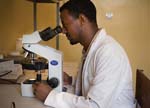
Using this model people view the human body in the same terms as a computer, or mechanical device — when something is wrong you take it to experts who maintain it. Physicians, unlike behavioural experts, often focus on treatment and clinical interventions with medication rather than educational interventions to bring about behaviour change.
About two months ago Serena lost her six month old twins. She is grief stricken. She was always slender but now she looks very thin. She cannot sleep, she cannot eat and she doesn’t want to talk to anyone. Do you think the view of health you have just read about applies to Serena?
This view of health ignores many of the social and psychological causes of ill health. Serena’s grief is not an illness but it is certainly affecting her health.
In the next section we will discuss the broader perspective of health which includes other factors in addition to physical ones. In your work as a Health Extension Practitioner you will be expected to diagnose the overall social, psychological and physical factors which affect the health of your community and you will have to think about effective interventions accordingly.
1.1.2 Broader perspectives of health
In the previous section you read about a narrow definition of health. This section will help you understand the concept of health in a broader and more holistic way, as defined in Box 1.2.
Box 1.2 Defining health 2
The most widely used of the broader definitions of health is that within the constitution of the World Health Organization (1948), which defines health as: ‘A state of complete physical, mental, and social well-being, and not merely the absence of disease or infirmity.’
This classic definition is important, as it identifies the vital components of health. To more fully understand the meaning of health, it is important to understand each of its individual components. The broader concept of health can help you as a Health Extension Practitioner when you are planning and implementing your health education activities at community level.
Think back to Serena. Describe her state of health.
Serena is mentally distressed. She does not by any means have ‘mental and social well-being’.
1.2 Physical health
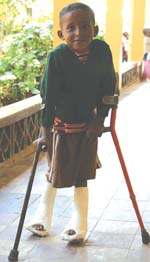
To understand physical health (Figure 1.2) you need to know what is considered to be physically unhealthy so that you can contrast the two (Box 1.3).
Box 1.3 Defining physical health
Physical health, which is one of the components of the definition of health, could be defined as the absence of diseases or disability of the body parts. Physical health could be defined as the ability to perform routine tasks without any physical restriction.
The following examples can help you to understand someone who is physically unhealthy:
- A person who has been harmed due to a car accident
- A farmer infected by malaria and unable to do their farming duties
- A person infected by tuberculosis and unable to perform his or her tasks.
Think about someone with physical damage, perhaps due to a car accident. Also think about someone in your community who you would consider to be physically disabled. According to the WHO definition do you see them as healthy?
While both of these people may be restricted in their movement and ability to do routine tasks they may still be in a state of physical and mental well-being.
Health is not limited to the biological integrity and the physiological functioning of the human body. Psychological health is also an important aspect of a health definition.
1.3 Psychological health
Think about people in the community who are showing behaviour that may indicate they are going through a period of mental distress in their lives. Or think about Serena again. Do you think that everyone in distress shows the same sorts of symptoms?
Sometimes it can be really hard from the outside to tell if the person is struggling with mental health issues, but at other times they show symptoms that suggest a lack of self-awareness or personal identity, or an inability of rational and logical decision-making.
At other times it might be apparent that they are not looking after themselves and are without a proper purpose in their life. They may be chewing khat, drinking alcohol and have a non-logical response to any request. You may also notice that they have an inability to maintain their personal autonomy and are unable to maintain good relationships with people around them.
So how do we recognise a mentally healthy adult?
You will learn more about mental health and ill health in the Module on Non-Communicable Diseases, Emergency Care and Mental Health.
The mentally healthy adult shows behaviour that demonstrates awareness of self, who has purpose to their life, a sense of self understanding, self value and a willingness to perceive reality and cope with its difficulties.
The mentally healthy adult is active, hard working and productive, persists with tasks until they are completed, logically thinks about things affecting their own health, responds flexibly in the face of stress, receives pleasure from a variety of sources, and accepts their own limitations realistically. The healthy adult has a capacity to live with other people and understand other people’s needs. It is sometimes considered that the mentally healthy person shows growth and maturity in three areas: cognitive, emotional and social.
The next part of this study session will help you understand these three components of psychological health.
1.3.1 Cognitive component
The cognitive component of mental health is really to do with thinking and being able to work things out. It includes the ability of an individual to learn, to have awareness (consciousness) and to perceive reality. At a higher level it also involves having a memory and being able to reason rationally and solve problems, as well as being able to work creativity and have a sense of imagination.
1.3.2 Emotional component
When you are implementing a health extension programme you may encounter various feelings or emotions in households in your community such as happiness, anger or sadness. People might cry or laugh. The emotional component of health is the ability and skill of expressing emotions in an ‘appropriate’ way. Appropriate means that the type of response should be able to match the problem.
Think about how you might react to such feelings if you came across them while you are working as a Health Extension Practitioner. What do you think of such feelings?
Suppose a secondary school student in your area, while sitting for an exam, started to cry uncontrollably? This could be due to their inability to control themselves in the stressful situation. Or could this suggest that they have a deeper emotional health problem?
Showing emotions like this is not something that you can immediately say, ‘oh this is exam nerves’. Knowing more about someone’s life is important. If you knew this student usually sailed through exams and was a calm, unflappable person, then you might begin to think this was something needing investigation. Or perhaps family circumstances are relevant here — maybe a beloved grandmother has just died.
In the previous section you have learned something about the physical and mental components of health. Social health is also an important component of overall health and in the next section you will consider the definition and some examples of social health.
1.3.3 Social component

The social component of health is considered to be the ability to make and maintain ‘acceptable’ and ‘proper’ interactions and communicate with other people within the social environment. This component also includes being able to maintain satisfying interpersonal relationships and being able to fulfill a social role. Having a social role is the ability that people have to maintain their own identity while sharing, cooperating, communicating and enjoying the company of others (Figure 1.3). This is really important when participating in friendships and taking a full part in family and community life.
Which of the following examples could be considered to contribute to social health? Explain your answers.
- a.Mourning when a close family member dies
- b.Going to a football match or involvement in a community meeting
- c.Celebrating traditional festivals within your community
- d.Shopping in the market
- e.Creating and maintaining friendship.
In reality all these events could have a social component and help towards building people’s social view of health. They all involve interacting with others and gaining support, friendship and in many instances joy from being with other people.
1.4 Health education
In the previous section you have learned something about the concept of health and within this section you will learn about health education. As a Health Extension Practitioner, health education is among the most important tasks that you are going to perform.
From your previous experiences, either as a worker or as a community member, what do you think health education is?
The purpose of health education is to enable your community members to develop accurate and effective concepts about their own health and the health of their family and their community. Health education is an important component of health extension programmes.
If you are able to deliver the right health education messages the people in your community will become aware of their health problems and of ways of preventing health problems for themselves and those around them. Health education is important in developing a positive attitude in order to support behaviour change voluntarily, and help people in the households in your area solve their own health problems where appropriate.
Health education uses a wide range of different educational methods and strategies to lead people to make the right decisions for themselves about their health (Box 1.4). Health education messages should be attractive and appropriate for the target audiences and will move the people individually or as a group to take their share of responsibility in preventing exposure to disease.
Box 1.4 Promoting healthy behaviours
Health education is a part of healthcare that is concerned with promoting healthy behaviours. Think of those people who as a result of receiving health education messages are now using an insecticide treated net (ITN), or the number of households that have constructed latrines so that they are able to protect themselves from disease.
A person’s behaviour may be the main cause of their health problems, but it can also be the main solution. It is through health education that you as a Health Extension Practitioner will be able to help people to understand their behaviours and how this behaviour affects their health. Your work will encourage them to make their own choices for leading a healthy life.
But Health Extension Practitioners are not expected to force them to change. Behaviour change comes through persuasion about the outcomes of unhealthy behaviour and its consequences on the health of the individuals, families and communities.
1.4.1 Rationale for health education
In the previous section you have learned something about the concept of health education. In this section you will learn about the rationale for health education.
Read this quotation from Dr Hiroshi Nakajiima who was the Director-General of the World Health Organization.
‘We must recognise that most of the world’s major health problems and premature death are preventable through changes in human behaviours and at low cost. We have the know-how and technology, but they have to be transformed into effective action at the community level.’
From your experience in your own community do you think that he is correct? If so think of some examples from your own experience.
Examples might include the treatment cost and possible disability due to malaria, and think of the reduction to exposure to malaria by ITNs.
You will learn more about the treatment and prevention of malaria in the Communicable Diseases Module of this curriculum.
The rationale for health education is as follows:
- To address the spread of communicable and non-communicable diseases within the community where you are working using health education principles
- Health promotion and disease prevention are strategies to address the health problems in a cost-effective manner as compared to the cost spent for treatment
- Most health problems in developing countries are easily preventable through awareness creation and community involvement
- The cause of most health problems (for example, the spread of HIV/AIDS) is human behaviour and the way to prevent these health problems is also through influencing human behaviour
- In the community where you are working currently, health education is an instrument to help people with symptoms of disease to seek treatment
- Health education methods and principles are important to help to steer adolescent and young children away from harmful practices and behaviours like substance abuse, teenage pregnancy etc.
These topics are discussed in detail in the Module on Adolescent and Youth Reproductive Health, in this curriculum.
Read the list again. This important list outlines the rationale for health education activities. Which items on the list do you think will be the most important for you in your role as a health worker in your community?
In fact all these items are important and together they make up the rationale for making an effort in health education (Figure 1.4). Of course in some communities certain health issues are more important than others.
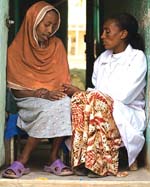
1.5 Health promotion
In the previous section you have learned about the rationale for making an effort in health education and now in this section you will learn more about the concept of health promotion.
Remember that the World Health Organization in its Ottawa Charter said that ‘health promotion is defined as the process of enabling people to increase control over, and to improve, their health’. The aim of health promotion is to reduce the underlying causes of ill-health so that there is a long-term reduction in many diseases.
Can you think of any examples of health promotion work that you as Health Extension Practitioner might be involved in? To help you think about this you may want to consider examples in your own community in the past few years (Figure 1.5).
Some examples include vaccinating children, implementing nutritional interventions, distributing ITNs at community level and destroying places favorable for the breeding of mosquitoes. These and other related activities are all part of health promotion. You may want to begin a list of other health promotion activities as you encounter them in this Module.
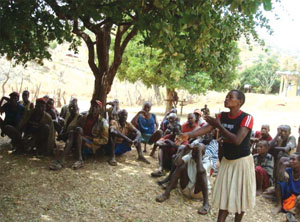
1.6 Finding out what’s going on in your community
Stop reading for a moment and assume that you want to know what are the priority health problems as well as possible resources within your community so that you can carry out your health education planning in the most effective way.
What do you think you could do to find out about the health problems and possible resources in the community you are working with? Bear in mind that we are talking here about the beginning of the process of thinking about these issues.
Diagnosis is the first step that should be used to understand the health problems in your community and is also needed to find resources and work out how to solve those health problems.
The first task for you as a Health Extension Practitioner in your work to change harmful behaviours will be to determine their causes. Just as physicians must diagnose an illness before it can be properly treated, the Health Extension Practitioner should diagnose or understand the behavioural, cultural and social context of her community before it can be properly changed.
If the causes of the unhealthy behaviours are understood by you this will be crucial to be able to intervene with the most appropriate and efficient combination of education, reinforcement and motivation.
1.6.1 Participation
Health education is an attempt to influence people’s behaviour towards healthy practices. Any attempt to implement health education in your community and to change behaviours will be most effective if the Health Extension Practitioner is closely involved with the individuals, families, community groups as well as kebele administrators and other stakeholders at community level.
Participation helps people to identify their own need for change and promotes the ability to choose for themselves methods and strategies that will enable them to take action. The participation of all community members is essential to gain support and also to be able to use locally available resources. Participation will help you to utilise local resources as well as build local partnerships and use community members as teachers and experts within their particular cultures.
Assume that in one of the villages you are working in you observed more malaria cases than previously had occurred. You had gone to the area and observed that there is one place favourable for mosquitoes to breed. You now want to use health education to enable the community to destroy the mosquito breeding site. Who do you think you should talk to first about this problem?
Participation of community leaders and other members of the community will be crucial for your health education session to destroy the breeding site. You will have to consider how to involve these key people before deciding how to conduct your health education sessions.
1.6.2 Using multiple methods and materials in health education
Human behaviour can be very complex, so in the effort to influence behaviour towards good health practices the Health Extension Practitioner is expected to understand different educational methods and a variety of media that she could use to conduct health education sessions. A mix of educational methods is important to hold the attention of your audiences and convey the messages to their best effect.
Now read Case Study 1.1 and give some reasons why Meron did not receive good feedback.
Case Study 1.1 Meron
Meron is a Health Extension Practitioner, who frequently goes to the local school to conduct health education sessions. Whenever she goes to the school she carries her posters, leaflets, charts and other educational materials with her. After class she asks her students in a feedback session about how the session has gone. She is always happy with the feedback she is given.
One day Meron went to school to create awareness on sanitation, but on that day she did not carry her educational aids with her. At the end of the class the feedback from the students is not as good as previously.
The feedback may not have been as good as she expected because she didn’t use different educational materials and the session may have been boring for her students. Also on this day she will only have used one method of communication – talking. Had she had her posters and other materials she would have been able to appeal to students in different ways.
1.6.3 Organising and planning
Unplanned health education sessions may well be a waste of effort. Planning and organisation are fundamental for Health Extension Practitioners in order to conduct effective health education and distinguish it from other incidental learning experiences.
The Health Extension Practitioner should decide in advance the what, why, how, who and when of each health education session. It is very important to make the health education planning participatory and include other people and groups if possible. Health education, starting from planning, through the implementation, monitoring and evaluation stages should always consider the active and full participation of the concerned audience.
Why do you think that it is a good idea to include representatives of your target audience when you are planning your health education activities?
The importance of including members of your audience when you plan health education activities is to get support and be successful in your health education sessions. If people feel they are involved then they are more likely to think the activities apply to them and to feel committed to them.
It is unthinkable to provide health education without scientific knowledge related to the topic or issues to be addressed. For example, the health educator must know the current scientific knowledge on how HIV/AIDS is transmitted and details of various prevention methods. This will be covered in the Communicable Diseases Module. Scientific knowledge is changing with time and your educational sessions will have to keep up with the latest developments (Figure 1.6).
Fatuma is a Health Extension Practitioner. While conducting a health education session on breastfeeding she said to her audience ‘I think HIV/AIDS might be transmitted from mother to child through breastfeeding’. What did you observe from the above scenario? How would you expect Fatuma to respond?
The Health Extension Practitioner should know that HIV/AIDS is transmitted from mother to child through breastfeeding, but that there are ways that the risk of this can be reduced. Health education activities should not be planned haphazardly but organised based on scientific findings and correct knowledge. You should not provide health education without scientific knowledge.
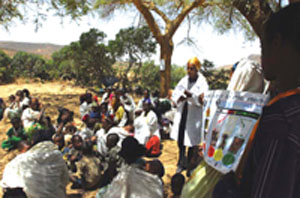
Now try this out for yourself.
Imagine that you are conducting a health education session in your local community. During your teaching you say ‘I think female genital mutilation (FGM) is harmful’ or ‘I think tobacco causes cancer’. What would be a better way of putting this?
Because your health education needs to be based on scientifically valid facts this is incorrect. You should be more confident and assertive. It is correct to say ‘female genital mutilation (FGM) is harmful’ or ‘tobacco causes cancer’. When you know something to be the case always express it as a fact.
1.6.4 Audience segmentation
Health education should be audience-specific and designed for the particular target group of people you are hoping to reach. As a Health Extension Practitioner you should select your audience for each of your specific health education activities. For example if you need to create awareness on prevention of mother to child HIV/AIDS transmission (PMTCT) your specific audience should be as many as possible of the pregnant mothers in your kebele. If you want to create awareness on the role of males in family planning services your target audience could be married males and male adolescents. Such segmentation of your audience makes your health education more effective.
Routine vaccination is among the activities you will be expected to implement at your community level (Figure 1.7). Suppose you want to conduct awareness creation on the advantages of childhood vaccination in your area. Who do you think should be your target audience for a health education session on childhood vaccination?
Pregnant women, parents and carers would be the target audience for the session. Remember the word ‘target’. It means being very specific.
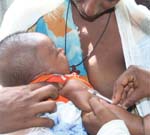
1.6.5 Needs-based assessment
Health education is best implemented after the real needs of the community have been assessed and identified.
Before involving any individual or group within your community in health education activities you should try and discover the felt needs of the community. There is no use making an effort conducting health education on issues that are not relevant for your local community because your activities will be wasted.
Take a moment to think of a health education activity that would be wasted in your community if you have not found out about community needs.
Imagine you want to raise awareness on HIV/AIDS in your local secondary school; your health education session might be wasted unless you identify what it is that the students want to learn. Another example is that there is no need to tell a lay person about all the latest research on a particular health problem when they may only be interested in knowing simple facts about what the problem is and its solutions. In fact overloading them with facts and figures might actually put them off.
Health Education activities should start from a place people are starting from themselves. Activities should consider current cultural beliefs and norms and slowly build up talking points to avoid any direct clash of ideas. This will allow people to become understanding and lead to the appreciation and the ability to take on fresh ideas.
Imagine that in the area you work in you conducted a health assessment and found that female circumcision or female genital mutilation (FGM) is very common. You know that female circumcision is a harmful traditional practice and want to change this. To change people’s perceptions and prevent this practice happening in the future is a complex issue — where do you start?
This is such a difficult and sensitive subject and should always be approached with great care. However, in general the Health Extension Practitioner should ideally try to understand the culture of the community and introduce novel ideas with a natural ease and caution. Using opposing statements that may be contrary to existing local beliefs, culture and practices of your community should be avoided. However such traditional harmful practices should be appropriately addressed (Figure 1.8).
FGM is very common and you will encounter it and it is a major topic in the Adolescent and Youth Reproductive Health Module.

1.7 Motivation
Motivation is usually expressed as a mental direction or a desire for doing or rejecting something. It is something that happens within the person, not something done to a person by others. It involves the internal dynamics of behaviours, not external stimuli such as incentives.
In health education, you can appeal to people’s motives through motive-arousing discussion, but not through external factors. Rather than ‘telling’ people the best action they should take, help them to learn about their health and encourage and motivate them to take steps to improve.
Assume that you are conducting a health education session among the antenatal women from your district who are thinking about what they should eat during pregnancy. What mechanisms do you think may be important to use in order to reinforce the messages to your audience? How do you think you might help to motivate them?
Your response may include, but not be limited to:
- Asking them what they know about the topic you are teaching (helping them draw on their own understandings will align with their lives and concerns)
- Repeating important issues you raised (giving people time to absorb your messages will help them compare this to their understanding)
- Encouraging those responding (valuing people’s views will be positive and help with motivation)
- Showing examples of the types of food they should eat during pregnancy (if people know what they can do to help themselves it can be motivating)
- Giving demonstrations of how to prepare and cook the beneficial foods (again knowing where to start can be motivating and make behaviour change not as daunting).
Summary of Study Session 1
In Study Session 1, you have learned that:
- Health is a broad concept containing several different aspects. Physical and mental health issues are often interrelated and wellness is expressed through the integration of mental, physical, emotional, spiritual and social health components.
- Health education will always be a really important part of your work as a Health Extension Practitioner. It can be defined as, ‘Any combination of learning experiences designed to facilitate voluntary action conducive to health’. You can use health education in your local community to promote health enhancing behaviour and help people make decisions using their own initiative.
- The principles of health education focus on diagnosis, participation and the involvement of your community members. As you practice your health education activities you will be able to use a mix of media and educational methods when planning and organising your sessions.
Self-Assessment Questions (SAQs) for Study Session 1
Now that you have completed this study session, you can assess how well you have achieved its Learning Outcomes by answering these questions. Write your answers in your Study Diary and discuss them with your Tutor at the next Study Support Meeting. You can check your answers with the Notes on the Self-Assessment Questions at the end of this Module.
SAQ 1.1 (tests Learning Outcome 1.1)
What do you understand by the following terms?
- Health
- Health education
- Health promotion.
Answer
Health: When broadly defined, it is a state of complete physical, mental and social wellbeing not merely the absence of disease or infirmity. According to this definition physical, social and psychological factors all contribute to health.
Health education: Health education is part of healthcare that is concerned with promoting positive health behaviours.
Health promotion: According to the Ottawa Charter ‘Health promotion is defined as the process of enabling people to increase control over, and to improve, their health’. Health promotion is aimed at reducing the underlying causes of ill-health so that there is a long term reduction in many diseases.
SAQ 1.2 (tests Learning Outcome 1.2)
Give three examples of health education activities you could do as a Health Extension Practitioner at community level to improve the health of your local community?
Answer
Distributing insecticide treated nets (ITNs) to control malaria, immunizing against measles and other types of vaccination among small children, and promoting breastfeeding, good nutrition in pregnancy, latrine construction and providing family planning services are all examples of health education activities.
SAQ 1.3 (tests Learning Outcome 1.3)
Which of the following statements correctly refer to basic features of health education and which are false? In each case, state what is correct or incorrect.
A Health education is solely concerned with giving people information about health issues.
B Good health education begins with diagnosis of the health problems of a community.
C Community participation is optional in health education. Most of the time it is not required.
D Using a mix of media in health education increases the chances of your health messages being understood and acted upon.
Answer
Statement A is false. Although talking at people, one-way communication, has some role in health education (for example when giving a talk), it is only a small part of the overall picture which includes many activities that are interactive.
Statement B is true. Initial diagnosis is crucial for beginning to build up health education. If you don’t understand a problem and its context, any health education activity will only be hit and miss.
Statement C is false. Community participation is central. You do health education with people not at them.
Statement D is true. A media mix will help you appeal to more people — if they don’t understand one part of your message the chances are they may be able to understand another part of your message in another medium.